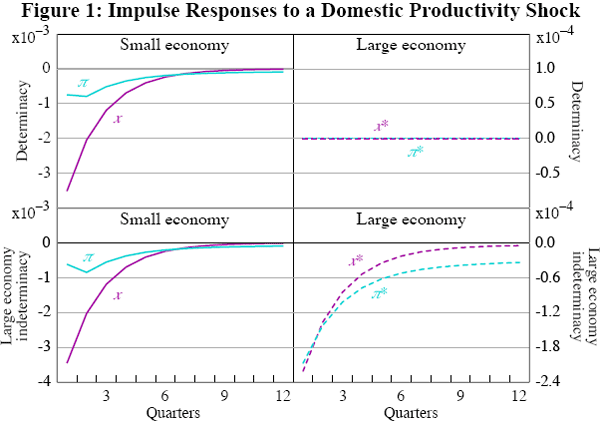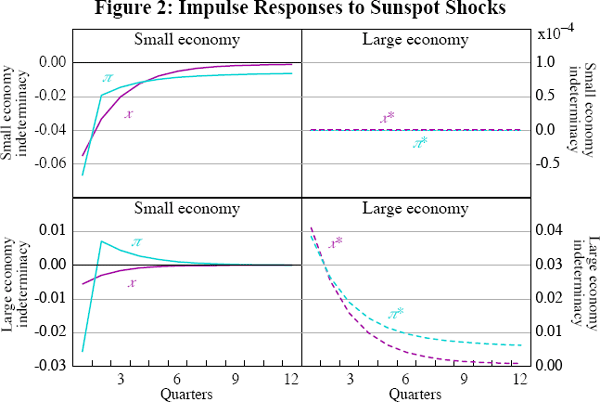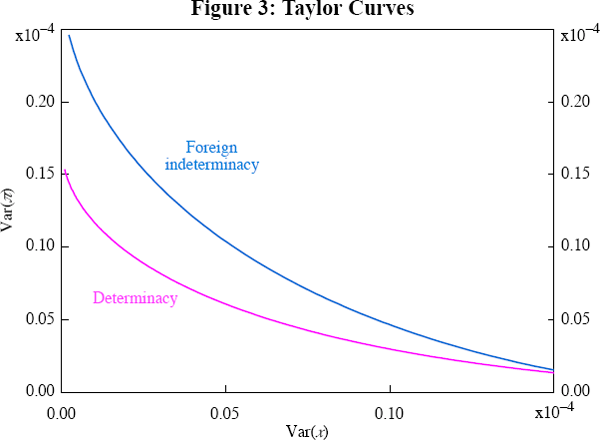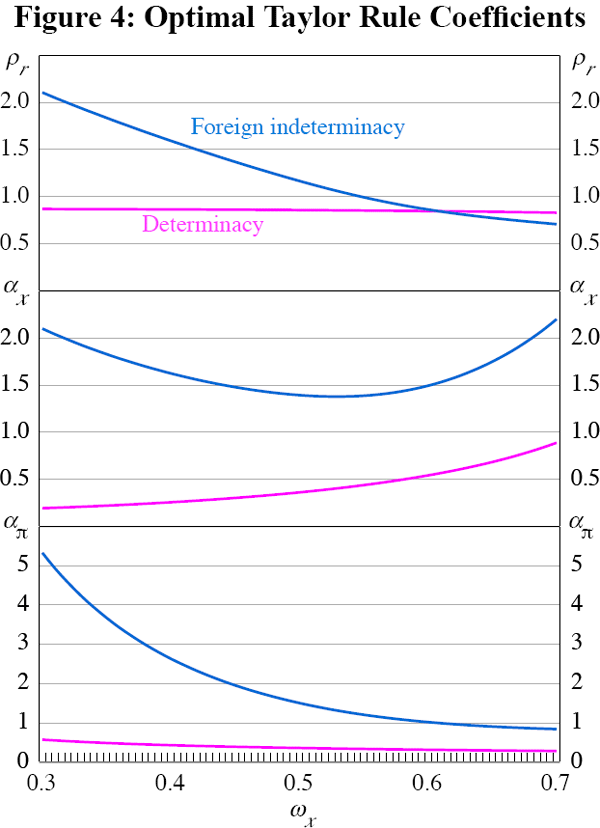RDP 2007-06: The Butterfly Effect of Small Open Economies 4. Results
June 2007
- Download the Paper 247KB
This section discusses two set of results: the dynamics of the model under determinacy and indeterminacy; and the implications for domestic monetary policy of foreign-induced indeterminacy.
4.1 Dynamics
Figure 1 illustrates the impulse response functions of inflation and the output gap
for the small and large economies after a positive productivity shock,  ,
to the small economy. The top panels of the figure show the responses under
the benchmark calibration (απ = 0.125 and
,
to the small economy. The top panels of the figure show the responses under
the benchmark calibration (απ = 0.125 and  = 0.125), which yields a unique REE.
= 0.125), which yields a unique REE.

The bottom panels show the same responses under foreign indeterminacy (with  =
0.075).[18]
=
0.075).[18]
Under determinacy, the solution to Equation (19) is unique, and the effects of the shock to the small economy are similar to those found elsewhere in the literature: a positive productivity shock decreases inflation, raises output, and raises potential output even more. And as expected, the large economy's variables do not react to this domestic shock.[19]
The bottom panels of Figure 1 illustrate the ‘butterfly effect’. Indeterminacy
generated in the large economy allows foreign variables to respond to the same
shock,  .
The responses of foreign variables are not large in magnitude; these are an
order of magnitude smaller than those of domestic variables, but they are clearly
not zero. Because this response would not have occurred if
.
The responses of foreign variables are not large in magnitude; these are an
order of magnitude smaller than those of domestic variables, but they are clearly
not zero. Because this response would not have occurred if  had remained at its
original determinacy consistent value, one can interpret
had remained at its
original determinacy consistent value, one can interpret  as a sunspot shock
for the large economy. In this way, the theory yields a plausible fundamental
interpretation for sunspot shocks. This finding, that shocks from the small
open economy operate like sunspot shocks for the large economy is, to the best
of our knowledge, new in the literature.
as a sunspot shock
for the large economy. In this way, the theory yields a plausible fundamental
interpretation for sunspot shocks. This finding, that shocks from the small
open economy operate like sunspot shocks for the large economy is, to the best
of our knowledge, new in the literature.
Figure 2 examines the responses to two types of sunspot shocks. The top panels show
the impulse responses of inflation and the output gap to a sunspot shock if
indeterminacy is domestically induced (απ = 0.075). The bottom panels show impulse responses
for the same variables to a sunspot shock if indeterminacy is induced abroad
( = 0.075).
= 0.075).

Figure 2 highlights important points that we have already discussed. It is not indeterminacy in itself that gives rise to a ‘butterfly effect’, but rather indeterminacy in the large economy. The top right-hand panel of Figure 2 shows that when monetary policy in the small economy is the source of indeterminacy, the large economy remains insulated from the effects of this shock. Neither fundamental nor sunspot shocks originating from the small economy affect the large economy as long as monetary policy in the large economy is consistent with determinacy. Only if the large economy pursues indeterminate policies do both economies become susceptible to sunspot fluctuations.
4.2 Taylor Curves
This section examines the extent to which foreign indeterminacy translates into additional volatility of the small open economy. It also examines the policy-maker's ability to mitigate the impact of (foreign) sunspot shocks on the domestic economy.
The objective of the policy-maker in the small economy is to set the parameters of the policy rule in Equation (10) so as to minimise a loss that is a weighted average of the variances of the output gap and consumer price inflation given by
where ωx denotes the weight attached to the stabilisation
of the output gap. Figure 3 shows two Taylor curves: one for which all parameters,
except those of the policy rule, of course, satisfy our benchmark calibration
(with foreign determinacy); and another one for which foreign monetary policy
violates Taylor's principle,  = 0.075. For the latter, we add a sunspot
shock with a standard deviation of 0.017, which is close to that of the foreign
aggregate demand shock, and we use the same indeterminacy solution as before.
= 0.075. For the latter, we add a sunspot
shock with a standard deviation of 0.017, which is close to that of the foreign
aggregate demand shock, and we use the same indeterminacy solution as before.

Foreign indeterminacy, and the sunspot shock associated with it, shifts the domestic policy-maker's efficient frontier and makes previously efficient points infeasible. In response to this higher volatility, we find that monetary policy's best response is to become more aggressive. This is illustrated in Figure 4, which shows the optimal parameter values of the policy rule associated with each of the Taylor curves of Figure 3.

Footnotes
Of the infinitely many solutions, we select the one given by Sims's (2001) code, which coincides with Lubik and Schorfheide's (2003) solution where, M1 (in their notation), is set to zero. It is important to note, however, that the ‘butterfly effect’, as we discussed above, is a general feature of any of the infinitely many solutions; and not only of the infinitely many solutions to this particular model, but of the infinitely many solutions of any model that satisfies the partition given in Equation (25). Obviously, as discussed above, the ‘butterfly effect’ is not a feature of the infinitely many solutions that would arise under domestically induced indeterminacy. [18]
If the solution to Equation (19) is unique, then so is the solution to Equation (23). [19]
